Lost in the Stars: Ode to a Pops Concert
I love the controlled chaos of a good pops concert - the colored lights, the handwritten music, the random stories, the guest musicians and dancers - the stars. No matter how professional the team, the element of chaos is always there, like a beloved, ultimately trustworthy - but slightly off-kilter - friend. The lack of predictability feels both thrilling and a little risky.
By now I've played in hundreds of pops concerts - starting as a college student with my stint in the Walt Disney World orchestra (three pops shows a night at EPCOT, for an entire summer), on through the decades in multiple orchestras from Omaha to Colorado to California and most recently last weekend with the Pasadena Pops ("Harlem Nights" with Michael Feinstein and guests) in California.
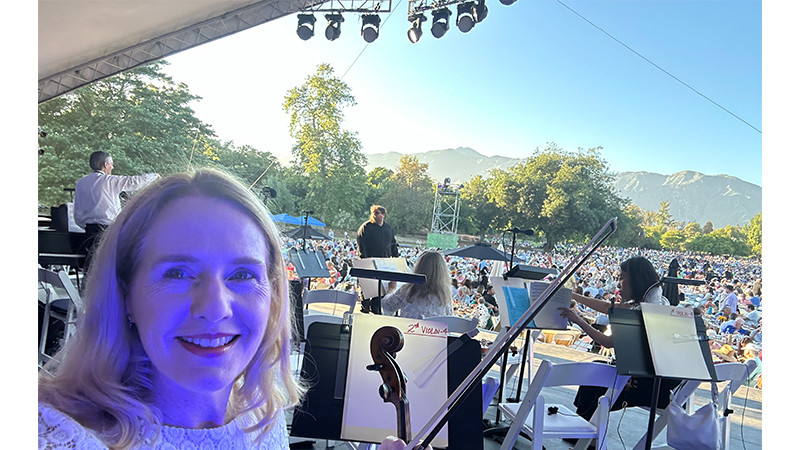
Laurie Niles, before last weekend's Pasadena Pops concert.
In a pops concert, there are always reams of music, dozens of charts - some printed, some hand-written. As a violinist who wants control over everything, not to mention a lot of time to practice, this used to send me into waves of panic. How can I possibly even begin to learn all this music? I learned: Sure, look at the hard stuff, but mostly - you'll learn it in the jungle, baby. It will work.
For this last pops concert I was a last-minute second fiddle sub, so two days before the first of two rehearsals I downloaded my 59 pages of music. Thank heavens for modern technology - when it's over, just hit "delete." In the old days our pops practice parts came in an envelope - a pile of paper that seemed as thick as a phone book (remember those?). Then after the gig one could either suffer the guilt of throwing away half a tree - or the stress of finding a place for a stack of music you'll almost certainly never play again.
That's because every singer and instrumentalist who does a pops show has particular arrangements, often a few written specifically to fit their vocal range, etc. Back in the Disney orchestra, we performed with a different guest artist every week, and each artist's arranger did a little Q and A with us. Rosemary Clooney's arranger told us that he had rearranged her songs with a very specific parameter in mind - as a life-long heavy smoker, she now needed to take more frequent breaths. He found elegant and inconspicuous ways to give her those breaks in the music.
But back to last week - it's always amazing to do pops a show with Pasadena Pops conductor Michael Feinstein, because there will always be some historically significant and rare arrangements in the mix. Not only is Feinstein a gifted singer, pianist and fabulous stage personality, he also is the founder of the Great American Songbook Foundation, headquartered in Carmel, Ind. Their Library and Archives was started in 2011 with Feinstein's own vast collection of original sheet music, memorabilia and more - and other collections have been added since.
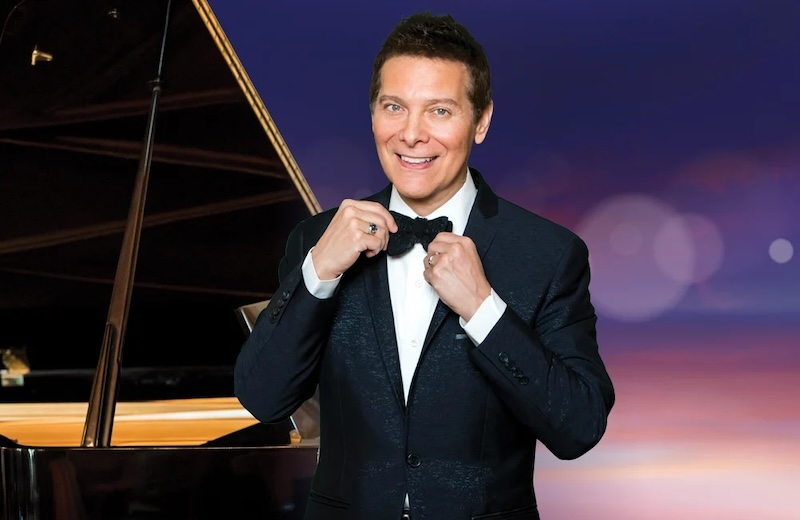
Pasadena Pops Music Director Michael Feinstein. Photo courtesy Pasadena Pops.
In a nutshell, the man is not just a fine musician but also a historian and preservationist whose knowledge of pops music runs deeper than just about anyone I've met. Also, it seems he has met everyone - Ira Gershwin, Ella Fitzgerald, Frank Sinatra, the aforementioned Rosemary Clooney, Tony Bennett...The stories he can tell!
Being in the orchestra, though, you don't really know these things until they are upon you. For example, in my 59 pages of music was a curious hand-written piece that listed no composer, called "Lost in the Stars." The title was double-underlined - this must have been done with a ruler, and a marker. At the first rehearsal, when we arrived at this piece, Feinstein mentioned that this particular orchestral arrangement had only ever been played once - for a 1949 live radio broadcast. "Maybe we'll see why!" he joked. I didn't catch the composer, but I loved the piece. (The key signature - with four flats - was written only on the first line, which had so many accidentals as to negate the flats, nonetheless you had to remember those four flats throughout. Pops chart - of course.)
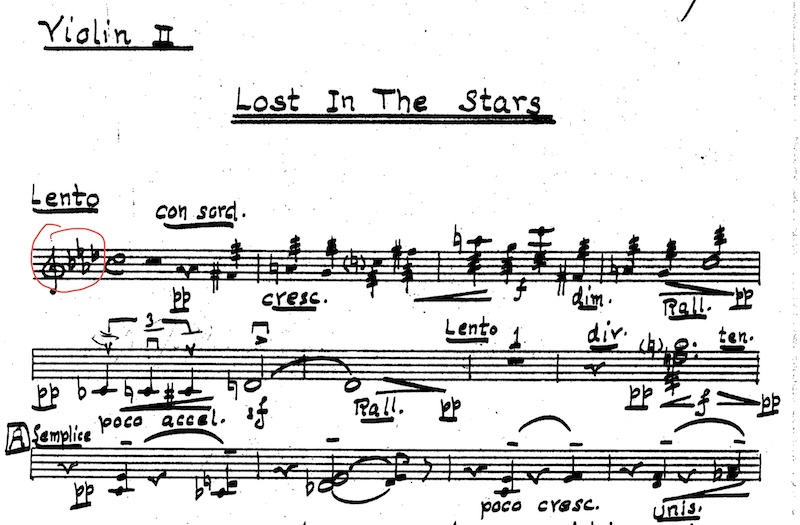
It had a soaring melody, lots of interesting harmonies. It transported me to a different time - the world mid-20th-century. It was not until the show that I heard Feinstein mention the composer: Kurt Weill! Such a sentimental piece for a composer I associate with the most sardonic of music - for example, "Mac the Knife" from his Threepenny Opera.
There are other recordings of the song "Lost in the Stars" (check out Sarah Vaughan), but this completely orchestral arrangement was unique, with the violins doing all the "singing." I looked it up later, "Lost in the Stars" turned out to be Kurt Weill's swan song - the last musical he wrote before he died six months later of a heart attack - at the age of 50.
But to take you to that moment in the concert: night had fallen, and out in the grass beyond the orchestra shell were thousands of people at tables, a lot of them happily drinking their wine. I was sitting in the orchestra, supplemented by a rhythm section and band, all of us in a high-tech orchestra shell full of microphones and lights. But still, we were definitely outdoors, sitting on folding white wooden lawn chairs. The night temperature was dropping, and the air was getting misty. A mosquito flew into the light and landed on our music - my stand partner Robert Miskey playfully tried to swat it away with the tip of his bow, to no avail. The peacocks that live at the LA County Arboretum - our venue for the evening - had been wailing from across the lawn all night, but they seemed to be quieting down a little.
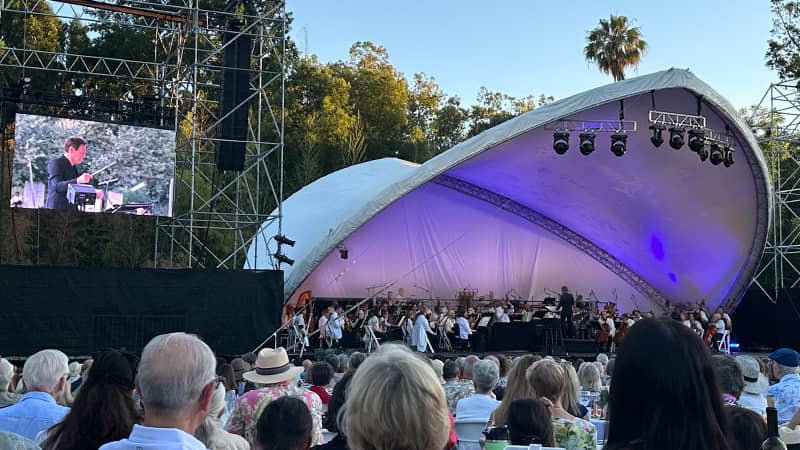
The Pasadena Pops, June 29 at the Los Angeles County Arboretum.
It was time for "Lost in the Stars." Four flats, no reminders, so remember the four flats. The music sounded like something from the earliest Disney films - I could picture Snow White singing it to the birds. It's music from my parents' childhood, music from a time when people were so heartbroken by two World Wars that they wanted to break with tonality itself - but not in this song. This song rushes straight into heartbreak - then, and now. In the back of the second violins, I relished that clashy but gorgeous C flat that changes it all with the harmony. Then suddenly, everything around me turned blue. Literally - the lights went blue, as they do. It's the pops, and it's all right. This music is so blue.
But blue wasn't the only vibe, and it never is. There was plenty of bright light - and stars. There are always stars in a pops concert. Sometimes I have never heard of the stars, sometimes I have. I remember playing a pops concert years ago, with Judy Collins, who was in her 70s at the time. Certainly I knew she was a star, but I hadn't heard her name in a while. Again, we had an overwhelmingly massive number of charts to play - we didn't even rehearse them all. During the rehearsal, she came on stage, but she sang everything in a perfunctory way, going through only the essential the motions. I felt slightly alarmed. Were we going to pull this off?
Then - the show. She flipped on like a light switch, and all of a sudden, a thousand watts of Judy Collins came beaming forth. Good god, she was amazing! Her delivery was flawless - great singing, engaging stories and stage banter. She reeled in that audience from the second she walked on stage, even before she said or sang a word. That's when I realized, certain performers simply have their own light and their own force of gravity - it's the very definition of a "star." They can channel so much wattage, maybe they can only turn it on when they need to. But I learned to trust in the "star." They'll bring it, it will work, baby. It's the pops.
Last weekend, both of the stars (and really there was a third, Feinstein himself) - brought it to rehearsals and shows alike. We had jazz singer Catherine Russell and trumpeter/singer Byron Stripling, and they absolutely delivered.
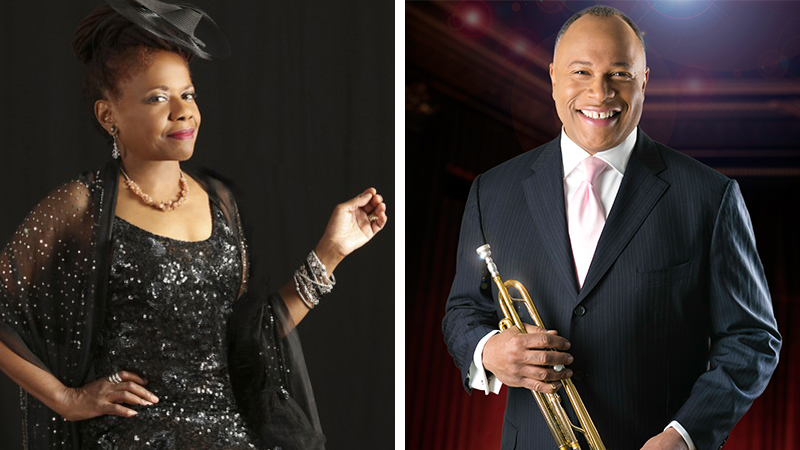
Singer Catherine Russell and singer/trumpeter Byron Stripling
Stripling in particular was over-the-top, in the best of ways. Pops concerts are designed for "over the top." We were playing Harlem Renaissance music - Duke Ellington, Ella Fitzgerald, Count Basie. At the end of a nice, swift Alexander's Ragtime Band, Stripling made the most satisfying theatrics of hitting a high note - we continued with our tremolo long after its expiration date as he pretended to make one attempt, then two, then adjusted his suit, then finally blasted us with that high, high note to end the tune. Mad cheering and applause! In "St. James Infirmary" he sang straight from the gut, with so much attitude, and then he made his trumpet taunt and growl and make all kinds of sounds one does not expect of a trumpet - Satchmo-style, but also his own Stripling-style.
Meanwhile, those of us who play regularly in symphony concerts had enough breaks in our music that we could occasionally just listen to some amazing solos from the jazz musicians who were joining us in the orchestra. After a certain clarinet solo, my stand partner and I turned to each other just to raise our eyebrows and mouth "OMG!" Same for many other solos - saxophone, trumpet. The rhythm section - pianist, bassist and drummer - jammed like crazy. It was such a privilege to share the stage with these jazz pros, and I could see my various symphony colleagues, grinning from ear to ear, shaking their heads in appreciation. And there were some gorgeous solos from orchestra members, as well - notably concertmaster Aimée Kreston.
So we took the "A" Train. We did the St. Louis Blues. We got into a Sentimental Mood. And yeah, it was a night for getting Lost In The Stars. Then we packed it up and left the stage, the grassy lawn, the bugs, and the night air - now cool and quiet. Along with a great mass of people, we walked in the dark, back to our cars.
Long live the pops.
You might also like:
- Interview with Violinist Tai Murray: The Joy of Touring and Teaching
- Weekend Vote: What do you find most challenging about outdoor concerts?
- Theme Park Cast Member Stories: On stage the first summer at Disney's Hollywood Studios
* * *
Enjoying Violinist.com? Click here to sign up for our free, bi-weekly email newsletter. And if you've already signed up, please invite your friends! Thank you.
Tweet
Replies
Very entertaining, Laurie. Hats off to you for adroit handling of strange copies!
That half-page of manuscript is a superior version of professional grade music copying, which post-computer is becoming a lost art. The manuscript first edition of John Williams Superman was so horrible that I chose to rewrite my own part.I used to do that, and my colleagues and students preferred my hand copies to the earlier computer versions. There was a style manual for learning that, and I remember that my musicians union phone book had a separate chapter for copyists.
Having only one key signature is a holdover from when songs stayed in one key. Arrangers and copyists should Not do that. What I do not need to see, as a violinist, is the treble clef at each line.
Solo pop songs in an orchestra pop concert has the practical problem of each singer having an optimum key for their range and vocal quality. Either they restrict themselves to available published versions, bring their own custom arrangements, or have the in-house arranger make a new one. I have read somewhere that in early Opera, before Gluck and Mozart, the leading soloists ("prima donnas") would ask the orchestra to transpose an aria to a different key from what was written. In my Mariachi violin jobs the leader announces the next (memorized) song, and-- the key (!).
So Joel, for your Mariachi work, do you just memorize certain standards in 4-5 different keys? Or..."put on a capo?" (!)
L.N.--
We learn a new song arrangement from a recording in a key preferred by the solo singer. The closest thing to a default, standard arrangement would be the first commercially successful recording, which is not necessarily the best arrangement. The recordings are sometimes in an odd optimum key for the singer, and not practical for live, memorized performance. The keys can change when the solo singer changes, or is tired that night and wants to drop it down a step(!) Most classical violinists would consider my job with M. Los Camperos to be crazy. We played every night with a rotating crew. I was the "floater" violin. I did not know until I arrived each night which part I would play; lead, 2nd or 3rd harmony violin. The leader would announce the next song and the key, and you would have about 10 seconds to calculate what to do. Instead of memorizing in multiple keys you transpose, which is where theory,interval recognition, memory by melodic contour is a big help.
This article has been archived and is no longer accepting comments.
Violinist.com is made possible by...
Dimitri Musafia, Master Maker of Violin and Viola Cases
International Violin Competition of Indianapolis
Johnson String Instrument/Carriage House Violins
Subscribe
Laurie's Books
Discover the best of Violinist.com in these collections of editor Laurie Niles' exclusive interviews.

Violinist.com Interviews Volume 1, with introduction by Hilary Hahn

Violinist.com Interviews Volume 2, with introduction by Rachel Barton Pine









July 3, 2024 at 05:54 AM · Sounds a lot more fun than the wedding gig I played last week. We in the quartet were reasonably well prepared but had 10 minutes to discover how to get together with a singer and an electric guitarist for All You Need is Love. The singer wanted to be in C but our music was in G...